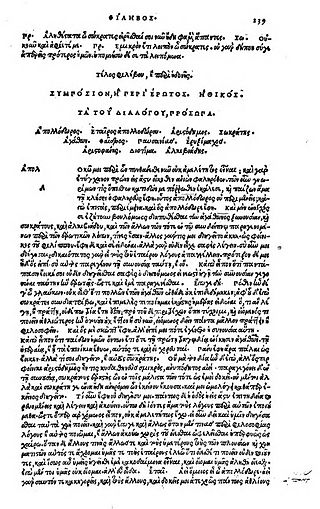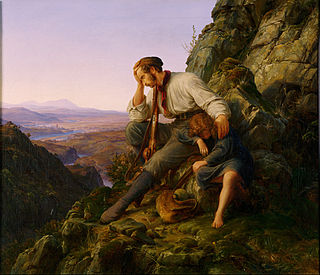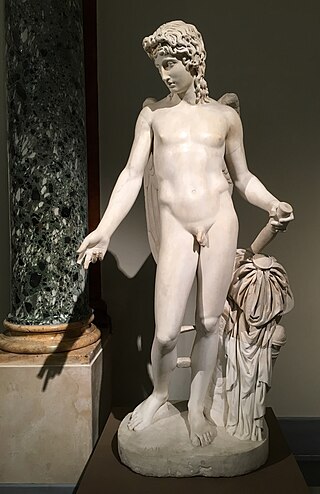
Clive Staples Lewis, was a British writer, literary scholar, and Anglican lay theologian. He held academic positions in English literature at both Magdalen College, Oxford (1925–1954), and Magdalene College, Cambridge (1954–1963). He is best known as the author of The Chronicles of Narnia, but he is also noted for his other works of fiction, such as The Screwtape Letters and The Space Trilogy, and for his non-fiction Christian apologetics, including Mere Christianity, Miracles, and The Problem of Pain.
Love encompasses a range of strong and positive emotional and mental states, from the most sublime virtue or good habit, the deepest interpersonal affection, to the simplest pleasure. An example of this range of meanings is that the love of a mother differs from the love of a spouse, which differs from the love for food. Most commonly, love refers to a feeling of strong attraction and emotional attachment.
In Christianity, agape is "the highest form of love, charity" and "the love of God for man and of man for God". This is in contrast to philia, brotherly love, or philautia, self-love, as it embraces a profound sacrificial love that transcends and persists regardless of circumstance.

The Symposium is a philosophical text by Plato, dated c. 385–370 BC. It depicts a friendly contest of extemporaneous speeches given by a group of notable men attending a banquet. The men include the philosopher Socrates, the general and political figure Alcibiades, and the comic playwright Aristophanes. The speeches are to be given in praise of Eros, the god of love and desire.
Platonic love is a type of love in which sexual desire or romantic features are nonexistent or have been suppressed, sublimated, or purgated, but it means more than simple friendship.

Philia is one of the four ancient Greek words for love: philia, storge, agape and eros. In Aristotle's Nicomachean Ethics, philia is usually translated as "friendship" or affection. The complete opposite is called a phobia.

Ancient Greek philosophy differentiates main conceptual forms and distinct words for the Modern English word love: agápē, érōs, philía, philautía, storgē, and xenía.

Eros is a concept in ancient Greek philosophy referring to sensual or passionate love, from which the term erotic is derived. Eros has also been used in philosophy and psychology in a much wider sense, almost as an equivalent to "life energy". The Protestant philosopher C. S. Lewis posits it as one of the four ancient Greek words for love in Christianity, alongside storge, philia, and agape.

Storge, or familial love, refers to natural or instinctual affection, such as the love of a parent towards offspring and vice versa.

Adelphopoiesis, or adelphopoiia is a ceremony practiced historically in Orthodox-Christian tradition to unite together two people of the same sex in a church-recognized relationship analogous to siblinghood.

Pederasty in ancient Greece was a socially acknowledged romantic relationship between an older male and a younger male usually in his teens. It was characteristic of the Archaic and Classical periods. The influence of pederasty on Greek culture of these periods was so prevalent that it has been called "the principal cultural model for free relationships between citizens."

Deus caritas est, subtitled De Christiano Amore, is a 2005 encyclical, the first written by Pope Benedict XVI, in large part derived from writings by his late predecessor, Pope John Paul II. Its subject is love, as seen from a Christian perspective, and God's place within all love. Charity is one of the three theological virtues; and the other two were treated in two successive encyclicals, one signed by Benedict and one written substantially by him but signed by his successor Pope Francis . This text begins with a reflection on the forms of love known in Greek philosophy—eros, agape, philia (friendship)—and their relationship with the teachings of Jesus.
Agape and Eros is a treatise written by the Swedish Protestant theologian Anders Nygren, first published in Swedish in two parts in 1930 and 1936.
Religious views on love vary widely between different religions.

In Greek mythology, Eros is the Greek god of love and sex. His Roman counterpart was Cupid ('desire'). In the earliest account, he is a primordial god, while in later accounts he is described as one of the children of Aphrodite and Ares and, with some of his siblings, was one of the Erotes, a group of winged love gods.

In classical mythology, Cupid is the god of desire, erotic love, attraction and affection. He is often portrayed as the son of the love goddess Venus and the god of war Mars. He is also known as Amor. His Greek counterpart is Eros. Although Eros is generally portrayed as a slender winged youth in Classical Greek art, during the Hellenistic period, he was increasingly portrayed as a chubby boy. During this time, his iconography acquired the bow and arrow that represent his source of power: a person, or even a deity, who is shot by Cupid's arrow is filled with uncontrollable desire. In myths, Cupid is a minor character who serves mostly to set the plot in motion. He is a main character only in the tale of Cupid and Psyche, when wounded by his own weapons, he experiences the ordeal of love. Although other extended stories are not told about him, his tradition is rich in poetic themes and visual scenarios, such as "Love conquers all" and the retaliatory punishment or torture of Cupid.
Philosophy of love is the field of social philosophy and ethics that attempts to describe the nature of love.
Brotherly love in the biblical sense is an extension of the natural affection associated with near kin, toward the greater community of fellow believers, that goes beyond the mere duty in Leviticus 19:18 to "love thy neighbour as thyself", and shows itself as "unfeigned love" from a "pure heart", that extends an unconditional hand of friendship that loves when not loved back, that gives without getting, and ever looks for what is best in others.

The colour wheel theory of love is an idea created by the Canadian psychologist John Alan Lee that describes six love styles, using several Latin and Greek words for love. First introduced in his book Colours of Love: An Exploration of the Ways of Loving (1973), Lee defines three primary, three secondary, and nine tertiary love styles, describing them in the traditional colour wheel. The three primary types are Eros, Ludus, and Storge, and the three secondary types are Mania, Pragma, and Agape.

The values that a person holds may be personal or political depending on whether they are considered in relation to the individual or to society. Apart from moral virtue, examples of personal values include friendship, knowledge, beauty etc. and examples of political values, justice, equality and liberty. This article will outline some current ideas relating to the first group – personal values. It will begin by looking at the kinds of thing that have value and finish with a look at some of the theories that attempt to describe what value is. Reference will be made solely to Western sources although it is recognised that many, if not all, of the values discussed may be universal.











